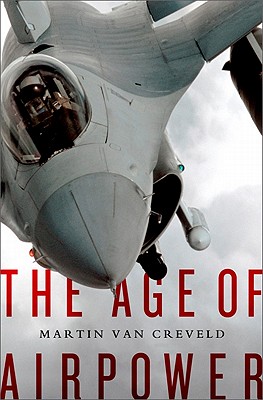 In The Age of Airpower, Martin van Creveld writes about the history and development of airpower. The book is divided into five parts: The beginnings, World War II, the Cold War, smaller wars from 1945 on, and what he calls “war amongst the people”, i.e. counterinsurgency warfare. As such, it provides a good historical overview of the use of airpower in war during the last 100 years. After humble beginnings in World War I, airpower matured during the interwar years and, according to van Creveld, reached its peak during World War II. No major battle was fought without it, it transformed warfare at sea (turning once-mighty battleships into anti-aircraft platforms and artillery in support of amphibious landings), and, in the form of strategic bombardment, wreaked havoc behind the frontlines in a way not possible earlier.
In The Age of Airpower, Martin van Creveld writes about the history and development of airpower. The book is divided into five parts: The beginnings, World War II, the Cold War, smaller wars from 1945 on, and what he calls “war amongst the people”, i.e. counterinsurgency warfare. As such, it provides a good historical overview of the use of airpower in war during the last 100 years. After humble beginnings in World War I, airpower matured during the interwar years and, according to van Creveld, reached its peak during World War II. No major battle was fought without it, it transformed warfare at sea (turning once-mighty battleships into anti-aircraft platforms and artillery in support of amphibious landings), and, in the form of strategic bombardment, wreaked havoc behind the frontlines in a way not possible earlier.
Van Creveld considers the introduction of nuclear weapons and jet engines as the two decisive factors that degraded the importance of airpower after WW II. Nuclear weapons took away the strategic role from aircraft, giving it to intercontinental and sea-launched ballistic missiles. He takes his argument one step further, and argues that fear of nuclear escalation has prevented countries in possession of nuclear weapons to wage war onto each other at all. In my opinion, this is not the only reason. I think that a profound socio-political change has taken place after WW II. Where war was once mostly limited to relatively small armies fighting each other out in the fields, WW II struck at populations themselves in a way that had not been seen before. Combined with the spread of democracy and the creation of the United Nations, war is simply not accepted anymore, whether nuclear or conventional, and has to be motivated by humanitarian reasons (such as the supposed presence of WMDs in Iraq).
The second development, jet engines, had impact on the efficiency of aircraft on the battlefield. Flying fast and high because they are too expensive to be able to afford losing them to increasingly improved air defenses (radar, SAMs), accuracy has suffered. Only precision-guided bombs have brought accuracy back to WW II fighter-bomber levels. In addition, fuel consumption reduces loiter times, making most jets ill-suited for close air support and interdiction purposes. Finally, drones are beginning to take over from manned aircraft – although drones are in my opinion airpower, too.
The part on “little wars” sings the praise of the Israeli Air Force in its wars from 1956 to 1982. Perhaps not surprisingly, since van Creveld is an Israeli, but his criticism on the use of Israeli airpower against insurgents is rather short. In other wars, as well in the “wars amongst the people”, he states that airpower has failed to play a decisive role. While he may be correct when it comes to the strategic bombing (countries such as Vietnam simply had barely an infrastructure worth an extended strategic bombing campaign) and interdiction (little use against small formations in mountainous or densely forested terrain), especially Vietnam has shown that, in the close air support role, airpower can still turn the tide of battle. Whether modern aircraft are suited for this is an entirely different question.
What I miss is a step further than only criticism, namely a vision of what airpower can be in the future, or what transformations it would have to undergo to stay effective in the future. I agree that the current aircraft, still designed based on Cold War requirements, but with development times of decades due to complex electronics, software, and materials, are not the solution. I think that drones for the reconnaissance and “surgical strike” (interdiction) role, and slow-flying, survivable aircraft for the CAS role (think of the A-10), might keep airpower an important part of the post-modern battlefield.
Conclusion: Sometimes controversial and with a few technical inaccuracies, but nevertheless an interesting and highly recommended book!